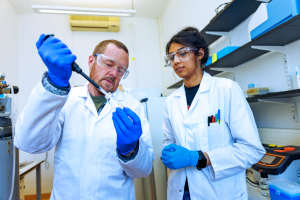Part of the broader Fusion Futures initiative, LIBRTI focuses on pioneering fusion fuel advancements and stimulating general industry capacity through international collaboration.
Over its four-year span, the programme aims to demonstrate controlled tritium breeding, a critical step for future fusion power plants.
As part of this effort, UKAEA will provide £9 million funding for 12 small-scale tritium breeding and digital simulation experiments.
Of these 12, Bangor University has been selected for its expertise to contribute to the LIBRTI Programme—a groundbreaking initiative aimed at advancing fusion fuel technologies.
The LIBRTI Programme seeks to create a world-leading UK capability for demonstrating the feasibility of powerplant-relevant fusion fuel technologies. A key focus of this initiative is the development of engineering-scale tritium breeder blankets—essential components that enable a fusion reactor to sustain its fuel supply by breeding tritium.
Bangor University is playing a vital role in this effort by developing new methods to ensure the safe and efficient operation of breeder blankets to be used within the fusion machine system. The University of Birmingham are supporting the work with access to data from their experimental facilities.
Dr. Cillian Cockrell, Lecturer in Mechanical at Bangor University, explains, “This is a foundational effort for the nuclear fusion industry. It’s about setting up the infrastructure to conduct the targeted research needed to make fusion power a reality.”
“Our contribution is building the supporting software infrastructure. By performing targeted experiments, we’re producing data to aid in our development of software tools to interpret operational data and guide future experiments. As these experiments become more sophisticated, we need to understand what the data are telling us. The software we’re building provides a framework to make sense of the data, predict outcomes, and determine next steps.”
The work involves modelling the inner workings of a key fusion reactor components, the breeder blanket, to validate physical theories and explain experimental observations in normal and off-normal conditions. This approach draws on a long history of simulation in traditional nuclear reactors, where direct measurements can be challenging due to safety constraints. In fusion engineering, however, such modelling is now requires adaptation.
Cillian adds “Over time, it will evolve into a more sophisticated model that can be applied to actual machines. What we’re building now is a seed—an essential part of a sustainable nuclear fusion industry. By the time future reactors are operational, this work will have laid the foundation for the final product”
Professor Simon Middleburgh, Co-Director of the Nuclear Futures Institute and co-investigator adds: “The project led by Cillian exemplifies the expertise within the Nuclear Futures Institute and adds momentum to the excellent collaboration with the UKAEA. We are looking forward to making impactful strides towards transforming the world-leading science and research into products that will ultimately be fuelling the clean energy future of the UK and internationally.”
Dr Tessa Davey, UKAEA Reader in Fusion Modelling notes “A key exciting part of this initiative is to also capture the degree of certainty for future fusion systems operating under various conditions. This can not only guide and accelerate development of future technologies, but also crucially builds in safety and confidence considerations throughout the scientific development.”
The potential of fusion energy is immense. It offers nearly limitless fuel, produces no greenhouse gases, and carries less of the long-term radioactive waste challenges associated with traditional nuclear energy.





